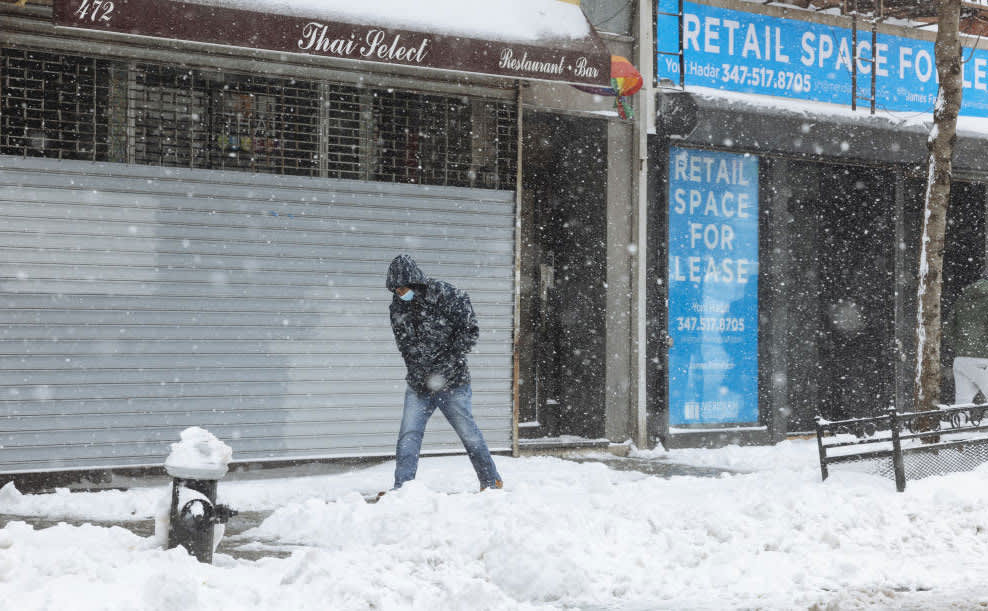A pedestrian wearing a protective mask walks past a closed restaurant as snow falls in New York, on Thursday, Dec. 17, 2020.
Angus Mordant | Bloomberg | Getty Images
January’s jobs report shows that Covid’s grip on the economy is relentless, but there are signs that pent-up demand and hiring could improve as the vaccine rollout gains momentum.
Some economists say the report, with just 49,000 jobs created, also shows that the economy is in need of a lift from fiscal stimulus.
A consensus of economists had expected that 50,000 payrolls were added in January, but some were more optimistic. NatWest Markets, for instance, was looking for 300,000 payrolls, and Citigroup was forecasting 250,000.
“It shows the job market remains in the clutches of the pandemic, and until we get broad vaccinations, we’re not going to stabilize the jobs market,” said Marvin Loh, senior global macro strategist at State Street.
“It was a really poor number,” he added. “It does show the lockdowns that started at the end of the year had a bigger impact.”
Pockets of pain, gain in some industries
The employment report shows pockets of pain where the economy was particularly hard hit by the virus, with hospitality and leisure down another 61,000, following a December decline of 536,000. That sector includes industries most hurt by social distancing, like restaurants, bars, casinos, hotels and entertainment establishments.
Education employment was a positive, reflecting a reopening of schools in some areas in January. Local government education rose by 49,000, state education jobs increased by 36,000 and private education added 34,000.
Professional services jobs gained by 97,000, but most of the gain was in temporary services jobs, up 81,000.
“The positive is you had more hours worked, people were working longer for those who had jobs,” said Peter Boockvar, chief investment officer at Bleakley Global Advisors. “That added to north of a 7% year-over-year increase in average weekly earnings.”
Average hourly earnings for employees on private nonfarm payrolls rose to $29.96 in January, up 6 cents from December. “It just shows that for people who are working, there are some wage increases that are helping,” Boockvar said “There are certain sectors were there’s not enough labor.”
It shows the job market remains in the clutches of the pandemic, and until we get broad vaccinations, we’re not going to stabilize the jobs market.
Marvin Loh
senior global macro strategist at State Street
Another positive was a 0.3% improvement in the average work week.
“This suggests that firms were unable to get workers in the door and were as a result forced to resort to longer hours for their existing workforce,” said Stephen Stanley, chief economist at Pierpont Amherst. “Meanwhile, average hourly earnings advanced by 0.2% after December’s 1.0% pop.”
That can be a precursor to more hiring.
“Overall, there still remains significant labor slack with unemployment and participation remaining far from pre-pandemic levels,” Bank of America economists said.
They noted that unemployment at 6.3% is still much higher than the 3.5% last February, just before the pandemic hit the U.S., “but we expect the recovery to reaccelerate this year amid strong fiscal support and the vaccine rollout.”
The Biden administration is proposing a $1.9 trillion Covid relief package to get the economy back on track and help individuals as the economy remains constrained by the virus.
Democrats in the Senate approved a budget resolution early Friday, setting up for a reconciliation process without Republican support.
“This report continues to signal we need that stimulus…and the chances that it’s reconciliation versus the more bipartisan approach is kind of front and center in the discussion,” said Loh of State Street.
President Joe Biden has said he would like a bi-partisan package, but that would likely be smaller due to GOP objections.
Using reconciliation, where Democrats could pass the plan with just 51 votes, would mean they could not use a similar process on further spending for another year.
